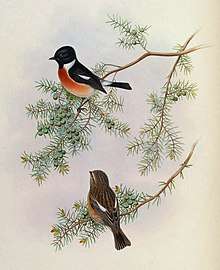Form and content
In art and art criticism, form and content are considered distinct aspects of a work of art. The term form refers to the work's composition, techniques and media used, and how the elements of design are implemented. It mainly focuses on the physical aspects of the artwork, such as medium, color, value, space, etc., rather than on what it communicates.[1] Content, on the other hand, refers to a work's subject matter, i.e., its meaning.[2]
Usage in art


Form is one of the most frequent terms in literary criticism. It is often used merely to designate a genre or for patterns of meter lines and rhymes. For example, the subject of these two artworks is a bird, though both artworks are created in different styles. One is a two-dimensional artwork of two birds resting on a tree branch, created in a natural style, with realistic proportions. On the other hand, the jade bird carving, created with exaggerated proportions and a stylized expression, creates a different emotional content. In other words, the content of the artwork changes based on the artist decision's use of form. [3]
Notes
- Barrenscott, Dorothy. "Focus on Research| The Elements of Art: Form, Content, and Context". Avant-Guardian Musings. Retrieved 5 April 2019.
- "How to Define Art".
- Barrenscott, Dorothy. "Focus on Research| The Elements of Art: Form, Content, and Context". Avant-Guardian Musings. Retrieved 5 April 2019.
Further reading